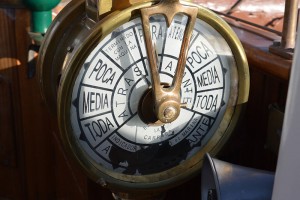“Just-in-time” sailing has been presented as one of the key factors for reducing the carbon footprint in sea transport, according to the report presented at the headquarters of the International Maritime Organization (IMO) following the research conducted by the Port of Rotterdam and the Dutch research institute, TNO. Their data corroborate the effectiveness of just-in-time as means of reducing CO2 emissions and allowing shipping companies save time and money.
What is Just-in-time shipping?
The “just-in-time” method originates from a Japanese organisation model. It essentially proposes the arrival of supplies at the factory and being dispatched “just in time”, in other words, doing away with inventory periods. This saving means a higher profit margin and more competitive prices for final products.
This philosophy has transcended many fields, and is essentially the same thing in terms of shipping: i.e., for ships to spend the least amount of time at a port. Or put another way, for this time to be fully efficient. This means that ships only arrive at port where there are proper conditions for them to be received and they do not need to wait to be docked. This often means that the ship will have to change its speed so as to arrive at just the right time, rather than before.
Savings in fuel and emissions
The main argument of the report is that if vessels at sea were better informed about the availability of moorings and could adapt their speed accordingly, they could make substantial savings in fuel and subsequently in CO2 emissions, as well as sulphur oxide and nitrous oxide. It underlines the particular importance of information in the 12 hours prior to arrival to allow ships to make the necessary decisions.
This also involves savings for shipping companies arising from shorter waits in berths. Astrid Dispert, Technical Advisor of the GloMEEP Project (Global Maritime Energy Efficiency Partnerships) highlights these two facets of the benefits of just-in-time, believing that “it is exactly these types of measures that can make a huge difference in the short term and help reduce the carbon footprint of maritime transport.”
Quieter and more efficient shipping
TNO and the Port of Rotterdam analysed all the container ship transits whose destination is the port of Rotterdam in 2017. Jan Hulskotte, Senior Researcher at TNO, explains that offering more precise information to ships can lead to a 4% (134,000 tons) reduction of CO2 emissions per year. “This is achieved by container ships adjusting their shipping speed by an average of 5%“, usually to reduce them. The sooner they receive the information, the greater the savings in emissions that would be made.
The test also envisages “just-in-time” having a positive impact at ports. Vessels in the freight sector sometimes have to wait for hours or even days, usually due to contractual obligations. According to Hulskotte, if this wait could be cut down by an average of 12 hours, this would have a major effect, with an annual reduction of 35% in emissions. “We are talking about 188,000 tons of CO2 and 1,000 tons of nitrous oxide.”
Technology to optimise the stop-over port
The port of Rotterdam is committed to step up its efforts in efficiency. One of its projects in this regard is the recent launch of “Pronto”, a platform for the optimisation of stop-over ports that combines data from different sources in order for ship stop-overs to be planned more precisely.
Therefore, the tasks and the services involved during stop-over are fully coordinated creating a detailed calendar for the time the ship is at the port, and avoiding dead time. “Pronto” also presents this data in graphic form in order for shipping companies to find out what they could save on fuel and CO2 if they changed to the optimum speed. This tool has certainly played a very important role in “just-in-time” shipping.


